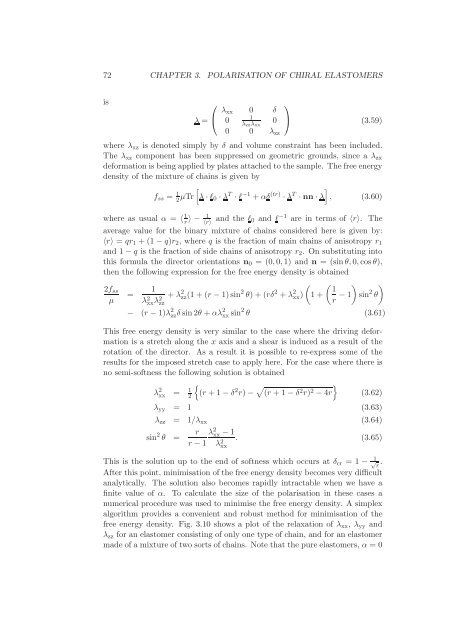Statistical models of elasticity in main chain and smectic liquid ...
Statistical models of elasticity in main chain and smectic liquid ...
Statistical models of elasticity in main chain and smectic liquid ...
Create successful ePaper yourself
Turn your PDF publications into a flip-book with our unique Google optimized e-Paper software.
72 CHAPTER 3. POLARISATION OF CHIRAL ELASTOMERSis⎛ ⎞λ xx 0 δλ = ⎝ 10λ zzλ xx0 ⎠ (3.59)0 0 λ zzwhere λ xz is denoted simply by δ <strong>and</strong> volume constra<strong>in</strong>t has been <strong>in</strong>cluded.The λ xz component has been suppressed on geometric grounds, s<strong>in</strong>ce a λ zxdeformation is be<strong>in</strong>gapplied byplates attached tothesample. Thefreeenergydensity <strong>of</strong> the mixture <strong>of</strong> cha<strong>in</strong>s is given by]f ss = 1 2[λ·l µTr 0 ·λ T ·l −1 +αδ (tr) ·λ T ·nn·λ , (3.60)where as usual α = 〈 1 r 〉 − 1〈r〉 <strong>and</strong> the l 0 <strong>and</strong> l −1 are <strong>in</strong> terms <strong>of</strong> 〈r〉. Theaverage value for the b<strong>in</strong>ary mixture <strong>of</strong> cha<strong>in</strong>s considered here is given by:〈r〉 = qr 1 +(1−q)r 2 , where q is the fraction <strong>of</strong> ma<strong>in</strong> cha<strong>in</strong>s <strong>of</strong> anisotropy r 1<strong>and</strong> 1−q is the fraction <strong>of</strong> side cha<strong>in</strong>s <strong>of</strong> anisotropy r 2 . On substitut<strong>in</strong>g <strong>in</strong>tothis formula the director orientations n 0 = (0,0,1) <strong>and</strong> n = (s<strong>in</strong>θ,0,cosθ),then the follow<strong>in</strong>g expression for the free energy density is obta<strong>in</strong>ed2f ssµ=1λ 2 xx λ2 zz+λ 2 zz(1+(r −1)s<strong>in</strong> 2 θ)+(rδ 2 +λ 2 xx)(1+( 1r −1 )s<strong>in</strong> 2 θ− (r −1)λ 2 zzδs<strong>in</strong>2θ +αλ 2 xxs<strong>in</strong> 2 θ (3.61)This free energy density is very similar to the case where the driv<strong>in</strong>g deformationis a stretch along the x axis <strong>and</strong> a shear is <strong>in</strong>duced as a result <strong>of</strong> therotation <strong>of</strong> the director. As a result it is possible to re-express some <strong>of</strong> theresults for the imposed stretch case to apply here. For the case where there isno semi-s<strong>of</strong>tness the follow<strong>in</strong>g solution is obta<strong>in</strong>ed{λ 2 xx = 1 2(r +1−δ 2 r)− √ }(r +1−δ 2 r) 2 −4r (3.62)λ yy = 1 (3.63)λ zz = 1/λ xx (3.64)s<strong>in</strong> 2 θ =rr −1λ 2 xx −1λ 2 . (3.65)xxThis is the solution up to the end <strong>of</strong> s<strong>of</strong>tness which occurs at δ cr = 1 − 1 √ r.After this po<strong>in</strong>t, m<strong>in</strong>imisation <strong>of</strong> the free energy density becomes very difficultanalytically. The solution also becomes rapidly <strong>in</strong>tractable when we have af<strong>in</strong>ite value <strong>of</strong> α. To calculate the size <strong>of</strong> the polarisation <strong>in</strong> these cases anumerical procedure was used to m<strong>in</strong>imise the free energy density. A simplexalgorithm provides a convenient <strong>and</strong> robust method for m<strong>in</strong>imisation <strong>of</strong> thefree energy density. Fig. 3.10 shows a plot <strong>of</strong> the relaxation <strong>of</strong> λ xx , λ yy <strong>and</strong>λ zz for an elastomer consist<strong>in</strong>g <strong>of</strong> only one type <strong>of</strong> cha<strong>in</strong>, <strong>and</strong> for an elastomermade <strong>of</strong> a mixture <strong>of</strong> two sorts <strong>of</strong> cha<strong>in</strong>s. Note that the pureelastomers, α = 0)
















